CIMAM 2022. Day 3: Learning from the Community: Collective Actions in the Face of Emergency
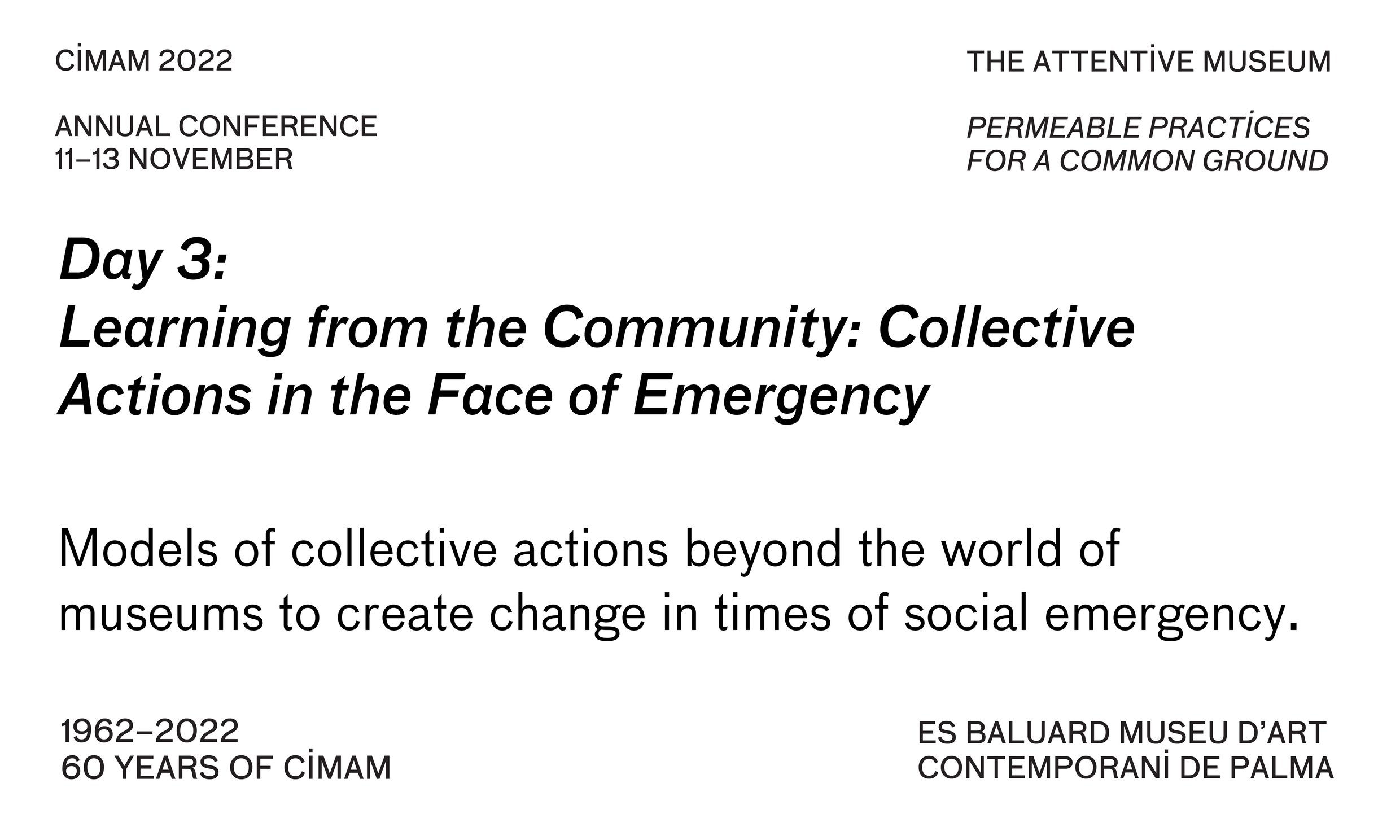
Day 3: Learning from the Community: Collective Actions in the Face of Emergency
The third day, "Learning from the Community: Collective Actions in the Face of Emergency," it will be fundamental to understand what the museum can learn collectively from civil society and how we can integrate the collective knowledge that is not in the museum as pedagogical, artistic, and political tools.

Keynote
Emily Jacir, Founder/Director, Dar Jacir for Art and Research, Bethlehem, Palestinian Territories
Our street in the middle of our house.
Transversal Methodologies and Decolonial Practices at Dar Jacir
Emily Jacir will share strategies and insights from the multi-faceted project Dar Jacir for Art and Research – a place devoted to educational, cultural, and agricultural exchanges in Bethlehem, Palestine. A process and practice-oriented platform, it is an experimental learning hub for the Bethlehem community and beyond.
Founded in 2014, Dar Jacir houses multiple programs grounded in shared encounters and hospitality. Through a participatory approach, collective knowledge is created, new works are produced, and structures for care and repair are fostered. Dar Jacir is valued by a broad public and deeply involved in community activity and collaboration in a particularly shattered territory. Intimacy is at the heart of the project. Artist-led, it facilitates and gives agency to artists and participants to lead, ask questions, and encounter international and local artists, thinkers, and cultural leaders.
Originally built in the late 1880s by al Mukhtar Yusuf Jacir, the site serves as a place in which the history and contemporary conditions of Bethlehem meet. The architecture of the home has enabled the development of innovative curatorial approaches offering opportunities for engagement that challenge the onset of the new ubiquitous neo-liberal structures throughout the area as the environment for art.
This paper will address the challenges of creating and sustaining access to culture in a community under siege and dispossession while subverting and transforming oppressive structures and social injustices, looking at forms of self-determination and autonomy.
BIOGRAPHY:
Emily Jacir is an artist, filmmaker, and educator who lives and works between Bethlehem and Rome. Her artistic practice spans a range of strategies including film, photography, sculpture, interventions, archiving, performance, video, writing, and sound. She investigates silenced histories, exchange, translation, transformation, resistance, and movement. Her works have been widely exhibited all over the world since 1994, and she has been honored for her achievements with several awards including a Golden Lion at the 52nd Venice Biennale (2007); a Prince Claus Award (2007); the Hugo Boss Prize at the Guggenheim Museum (2008); the Alpert Award (2011) from the Herb Alpert Foundation; and the Andrew W. Mellon Foundation Rome Prize Fellow at the American Academy in Rome (2015); among others. She is the founder and Executive Director of Dar Yusuf Nasri Jacir for Art and Research in Bethlehem.
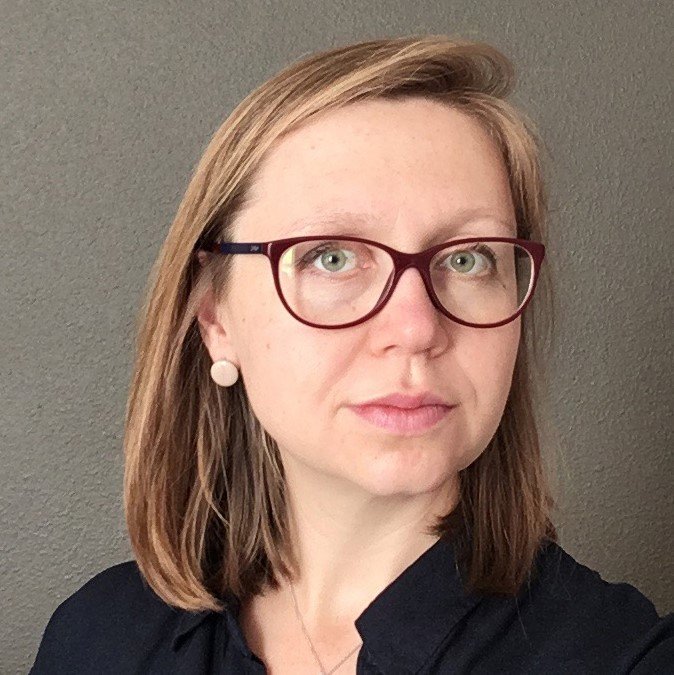
Perspective
Lada Nakonechna, artist, Method Fund, Kyiv, Ukraine
Not Waiting for the Emergency.
Collective practice in Ukraine that requires museums
Contemporary art in Ukraine is developing primarily thanks to the work of collectives, groups, communities, and grassroots initiatives. This presentation will emphasize the way in which these initiatives enter into relations with institutions, what kind of attitudes are required, and how institutional relations are imagined.
Specifically, it will examine the research and artistic seminar that the Method Fund has built in collaboration with the National Art Museum of Ukraine, titled ‘Socialist Realism. Seeming to be Another.’
While acquiring Socialist Realist art from the collections and archives of the National Art Museum of Ukraine, our goal was to examine the conditions under which it was created. At the same time, seeing contemporary art as a radical emancipatory method, the series of performative interventions into the exposition of the Socialist Realism period were conceived with the purpose of self-decolonization.
At some level, the artistic seminar provided the opportunity to reflect on the social identities constructed back in the Soviet era. Museums were forceful tools of Soviet politics, as through them a certain vision of history and reality was formed. What is a crucial is that the historically shaped perspective is still partly embodied in contemporary institutions. We clearly observe now how the legacy of Soviet Union with its terror and omnipresent newspeak plays a key role in the present state of war. Work on the representation of Socialist Realism in the museums appeared urgent, while also requiring untimely slowness, which the museum allows.
BIOGRAPHY:
Lada Nakonechna is an artist and researcher based in Kyiv. In addition to her individual practice, she is involved in a number of group projects and collectives. Since 2005, she has been a member of the R.E.P. group; since 2008, part of the curatorial and activist union Hudrada; and since 2015, a cofounder of Method Fund, and, together with Kateryna Badianova, co-curator of its educational and research programs: Course of Art and CreatingRuine.net. In 2016, she joined the new editorial board of Prostory.net.ua, an online art, literature, and politics magazine. Her artworks, which often take the form of installations incorporating drawing, photography, and text, call attention to methods of recognition, revealing the internal aspects of visual and verbal structures. Her latest investigations are based on artistic and archival materials related to Socialist Realism — understood as a “method” and institutional and educational system. Her work has been exhibited widely in such venues as the National Art Museum of Ukraine; Museum of Modern Art, Warsaw; Galerie für Zeitgenssische Kunst, Leipzig; Palais Populaire, Berlin; Museum of Contemporary Art, Zagreb; Kunsthalltrondheim, Norway; Kunstmuseum, Wolfsburg; and Center for Contemporary Art at NaUKMA, Kyiv. In 2014, she received the Kazimir Malevich Art Award.
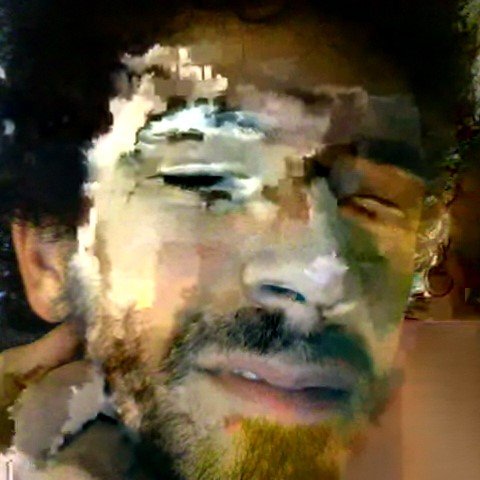
Perspective
Philip Rizk, film-maker/artist, Mosireen video collective, Cairo, Egypt
Did You Hear That?
In the book Les damnés de la terre, Frantz Fanon wrote, ‘the yardstick of time must no longer be that of the moment or up to the next harvest, but must become that of the rest of the world.’ Much of Fanon’s clarity came from the urgency of writing with his impending death in sight. Are we today in such a different place? If so, how can we enact such urgency? Fanon felt the heartbeat of the times, he heard the warning signs, and he saw much of what it would bring in the future. Learning from the community requires such an act of radical listening. This paper will take you on a brief journey from 2011 Egypt and 2012 Syria to recent forms of mass marches on the borders of the USA and Europe, asking the question: How do we prepare for the next time?
BIOGRAPHY:
Philip Rizk is a filmmaker and writer from Cairo living in Berlin. In his films, he experiments with methods of “making the habitual strange.” In Out on the Street (2015), he uses performance. In his found footage films Mapping Lessons (2020) and Terrible Sounds & Wonderful Things (2022, work in progress), he experiments with the technique of montage. In a world that is breaking down, a question that runs throughout Rizk’s projects is: “How do we prepare ourselves for what is to come?” He is a member of the Mosireen video collective behind the archive 858.ma. His texts include the essay “2011 is not 1968: a letter to an onlooker,” and the co-authored book (with Jasmina Metwaly) On Trials: A Manual on the Theatre of Law (Archive Books, 2021). He occasionally teaches in classrooms and workshops. His work can be followed @ filfilfilm.com.
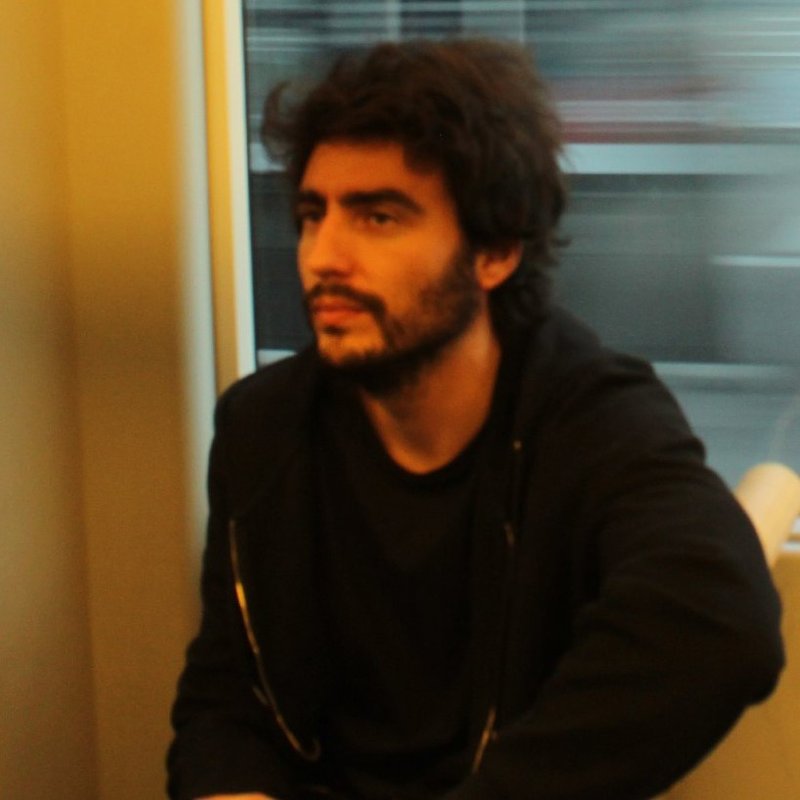
Perspective
Kike España, Dr., Architect, Urban researcher, La Casa Invisible, Malaga, Spain
The Softness of the Holes
The experience of the social and cultural center of La Casa Invisible in Malaga provides a situated understanding of the complex concatenations between artistic and political practices in a city trapped by the attractions of tourism. La Casa Invisible is a hole in the brilliant city, in the official discourse of the city of museums.
A hole is a rupture and a refuge. It is a rupture because it breaks with what is ther;, it is a cut. And it is a refuge because in addition to breaking it takes care, because it offers a welcome in a space that opens up a new inhabitability. La Casa Invisible is a way of fleeing from the city without leaving it, of making a hole in the city in order to inhabit it. And there is always a softness that makes its way through the holes. That softness is what dissolves disciplines, individuality, normativity, and also is what brings together, what cares, what allows sociality. That softness of La Casa Invisible is a way of assembling without dissolving into the one, of remaining invisible and unruly without disappearing into the touristic mall.
BIOGRAPHY:
Kike España participates in the social and cultural center La Casa Invisible as activist and researcher, is one of the editors of the publishing house Subtextos, and is part of the collective bookshop Suburbia in Málaga. He trained as an architect and has a PhD in urban theory from the University of Seville. He collaborates in the Overtourist City research project of the School of Architecture of the University of Málaga. His more recent publications include the book Die sanfte Stadt (2021, Transversal Texts), the articles “La ciudad contra el Estado” (2020, Scienze Del Territorio) and “Städte zu verkaufen: Prozesse der Enteignung und Praktiken der Wiederaneignung in Spanien” (2019, sub\urban) and the book chapter “The City of Attractions” (2019, MNCA Reina Sofía).
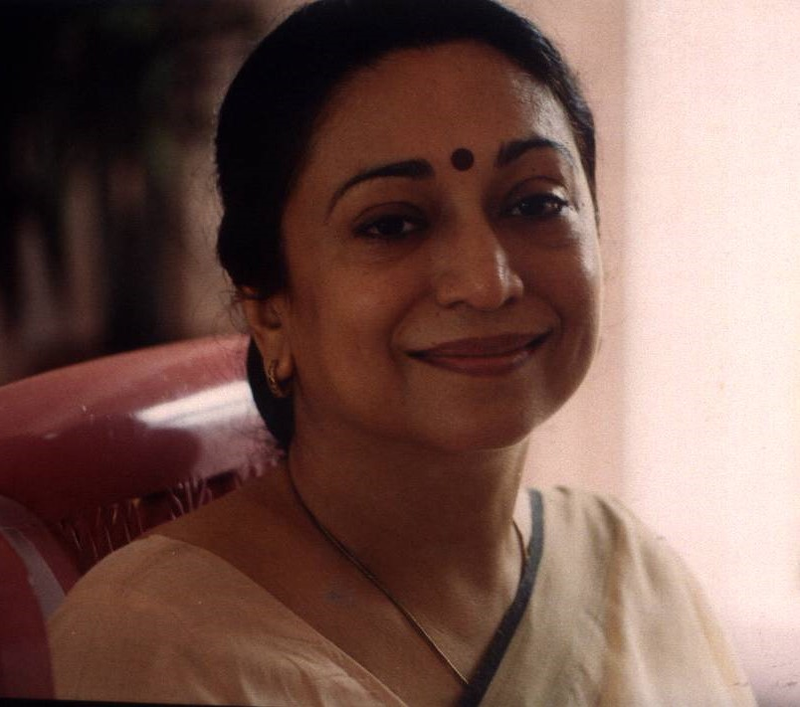
Perspective
Meenakshi Gopinath, Founder-Director, Women in Security Conflict, Management and Peace (WISCOMP), New Delhi, India
The Symbol & the Substance: The Ethics of Care in an Embattled World
The world is today in a liminal space, where the old is dying and the new has yet to be born. To live in today’s world is, for many, to live a life of paradox and contradiction. Unprecedented breakthroughs in science and technology coexist with symptoms of decay and despair. New crises plummet unprecedented numbers of human beings into ‘precarity’ – economic, social, and psychological. The added disruptions caused by COVID have completely reconfigured the world as we knew it – revealing the Janus face of the anthropocentric and androcentric paradigms of ‘progress’ and its associated pathologies.
This presentation is an invitation to dialogue on how a new conceptual vocabulary for an ethics of care can be scripted for today’s embattled world. It asks the following questions:
How can the ethics of care be infused and enriched by ideas of both interconnectedness and inter-sectionality to restore the canvas of coexistence in fractured societies? How do we distinguish between survival and resilience? How have communities defined ‘care work’ especially during the pandemic and in situations of violent conflict? How have women’s movements attempted to link the ‘ethics of care’ with issues of justice for those in the shadows of silence by pushing for recognizing ‘invisible’ care work and labor. How does the concept of the ‘relational self’ and ‘restorative activity’ find resonance in the work of communities that attempt to expand ‘healing spaces’ in organizations and societies beyond transactional relationships?
Can we draw lessons from the environmental movements in the Global South, mostly led by women, with their emphasis on indigenous knowledge systems and mutuality to provide us with the alphabets for an alternative paradigm?
BIOGRAPHY:
Meenakshi Gopinath is currently Chair, Centre for Policy Research, and Founder-Director of Women in Security, Conflict Management and Peace (WISCOMP), an initiative that promotes the leadership of South Asian women in the areas of peace, international affairs and regional cooperation. She is also Principal Emerita of Lady Shri Ram College, a premier women’s institution in India. A member of multi-track peace initiatives in South Asia, Meenakshi’s work and several publications focus on Gender, Security, Peacebuilding and Education. Her interests also include issues of human rights and gender, conflict transformation, Buddhist and Gandhian philosophy and the performing Arts. She was the first woman to serve on the National Security Advisory Board of India. She serves on the Boards of several Civil society initiatives for peace and nonviolence as well as educational institutes.
In recognition of her contribution to the field of women’s education and empowerment, she has received several national and international awards including the National Honour of Padma Shri. She also held the L.M. Singhvi fellowship at the David Davies Memorial Institute of International Studies (DDMI), University of Wales, Aberystwyth, Visiting MacArthur Senior Fellowship at Nanyang University, Singapore, was conferred the Honorary Doctorate Degree of Letters (Honoris Causa) for significant contribution to the education of women and commitment to global peace, La Trobe University, Australia, She was Distinguished Visiting Scholar, School of Social Sciences, Monash University (2015).